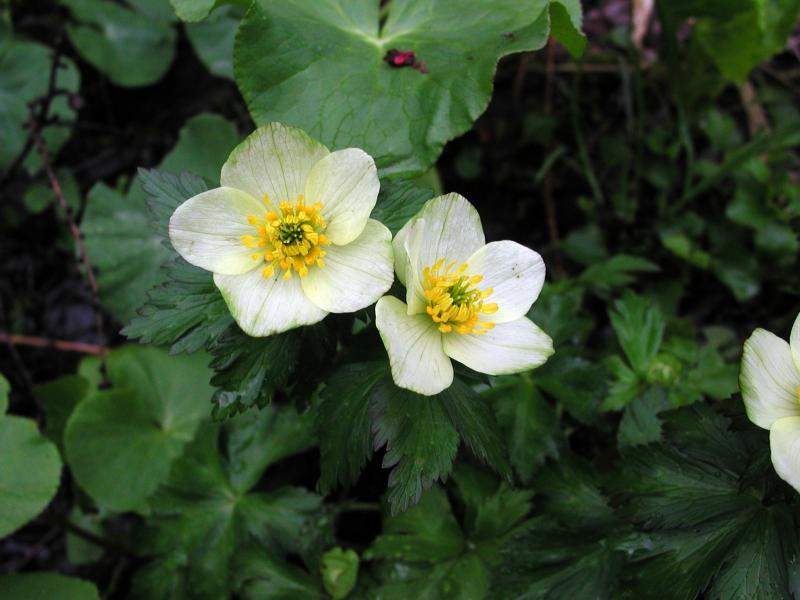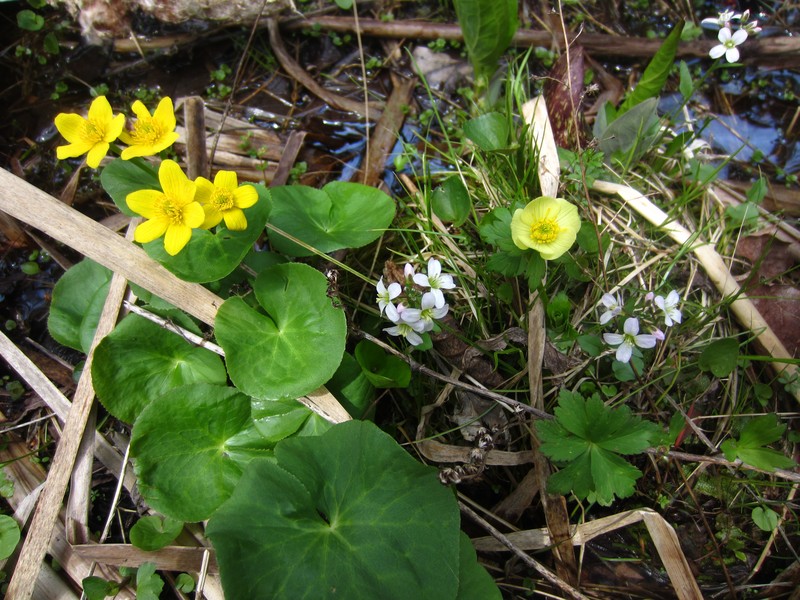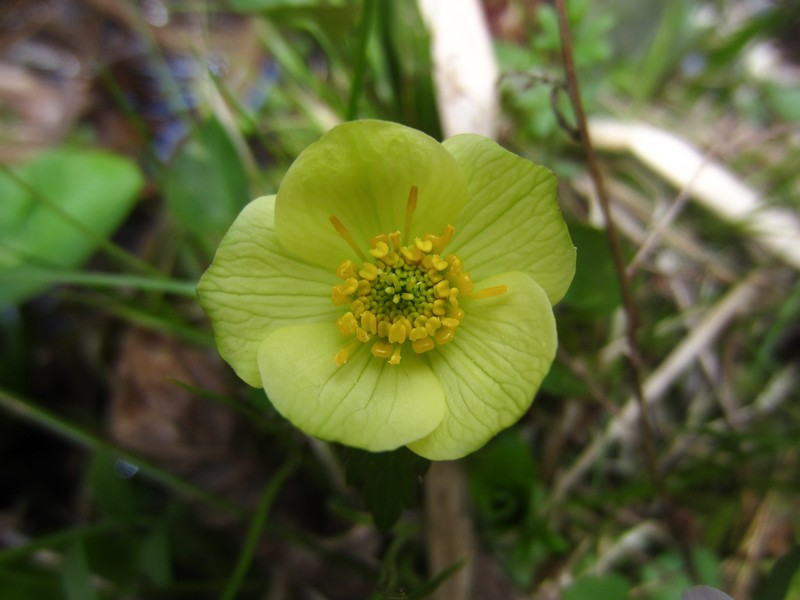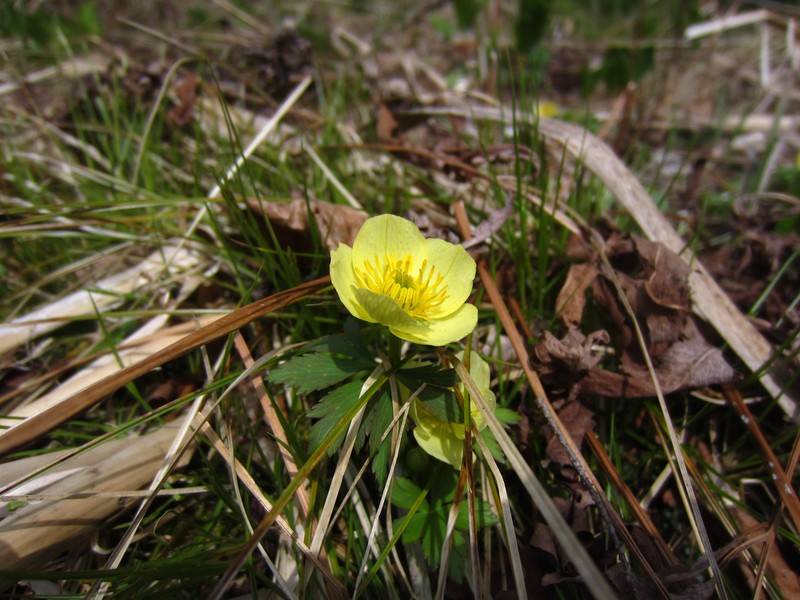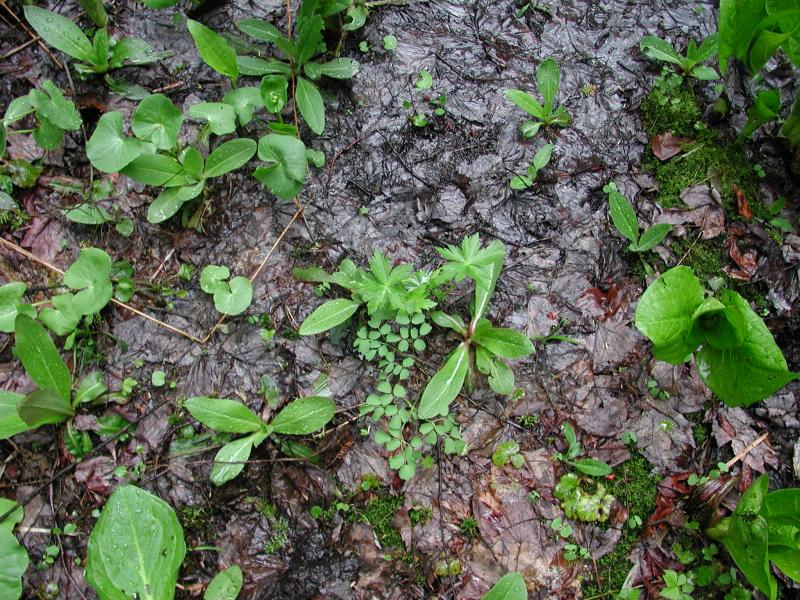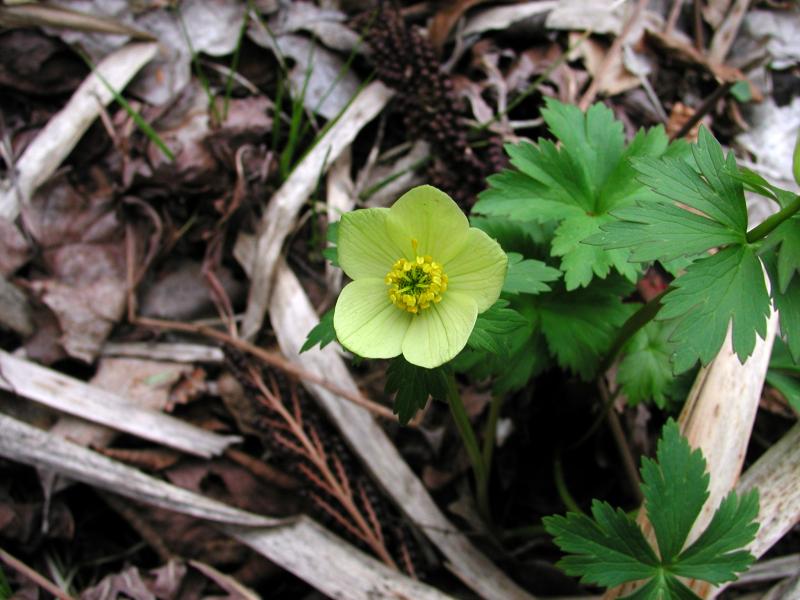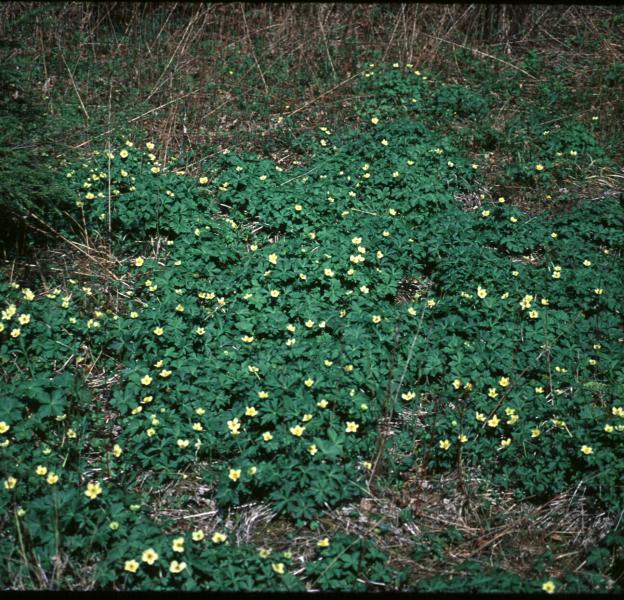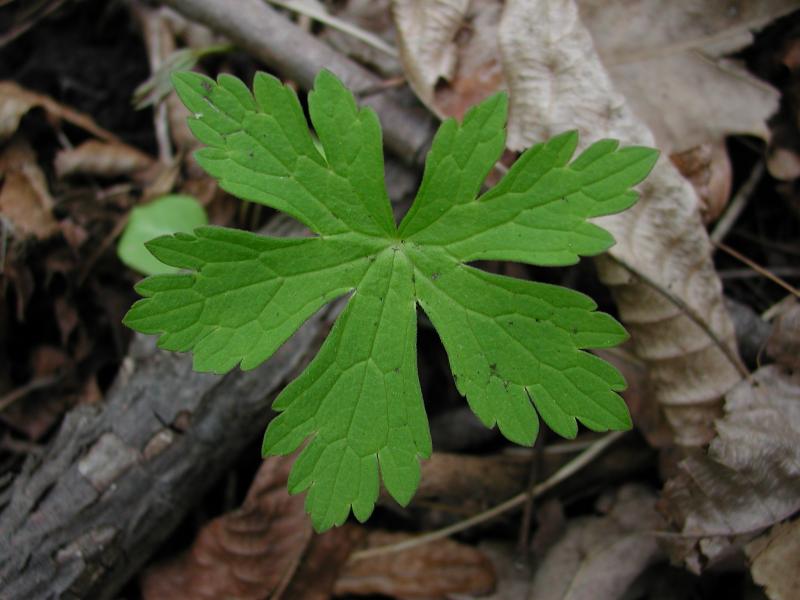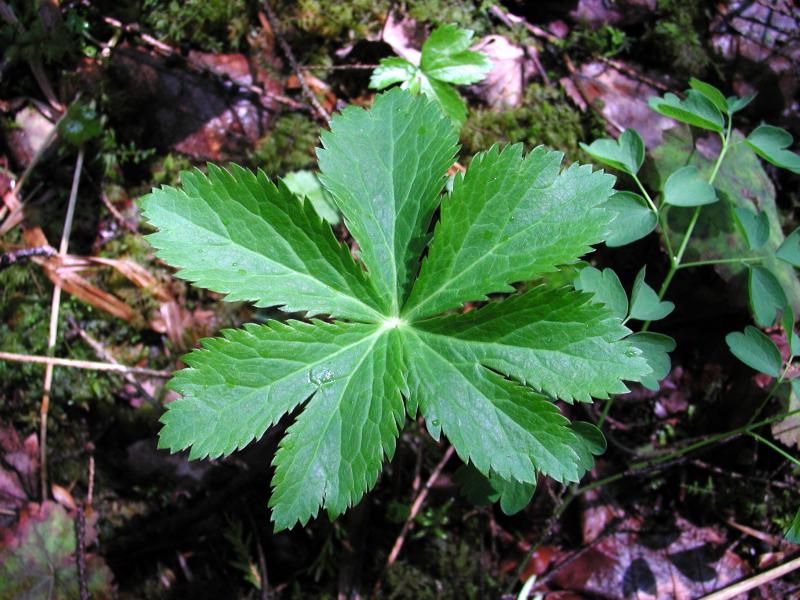Spreading Globeflower
Trollius laxus Salisb.
- Class
- Dicotyledoneae (Dicots)
- Family
- Ranunculaceae (Buttercup Family)
- State Protection
- Rare
A plant listed as Rare by New York State. Removal or damage without the consent of the landowner is prohibited.
- Federal Protection
- Not Listed
- State Conservation Status Rank
- S3
Vulnerable in New York - Vulnerable to disappearing from New York due to rarity or other factors (but not currently imperiled); typically 21 to 80 populations or locations in New York, few individuals, restricted range, few remaining acres (or miles of stream), and/or recent and widespread declines.
- Global Conservation Status Rank
- G5T3
Vulnerable globally - The subspecies/variety is at moderate risk of extinction due to rarity or other factors; typically 80 or fewer populations or locations in the world, few individuals, restricted range, few remaining acres (or miles of stream), and/or recent and widespread declines. (The species as a whole is common globally.)
Summary
Did you know?
The majority of the world's populations of spreading globeflower are found in central New York. Without these populations, this plant may be listed as a federally endangered/threatened species and at much greater risk to extirpation. Central New York is critical to the long-term protection of this species.
State Ranking Justification
There are approximately 30 known populations of this plant, eight of which are rather small. There are another 31 historical populations, many of which are feared lost. This plant is threatened by habitat succession, changes to water quality, and hydrological changes. The majority of the world's populations are found in New York, so New York is critical to the long-term protection of this species.
Short-term Trends
While New York is the central range for this species, there has been a marked decline over the past 100 years. This decline has been due to habitat conversion. Approximately 60 populations have been reported over the last 100 years, but today only half that number is known. In the Hudson Valley, the decline has been more dramatic where only one population out of six reported now remains. Even this single remaining population has declined from about 1500 plants in 1990 to an estimated 150-200 plants in 1999. This decline was mainly due to natural succession where shrubs are shading these plants.
Long-term Trends
It is speculated that prior to European settlement this plant was more common within the same range where it is known today. As wetlands were drained or converted, a number of populations were likely lost. This is certainly what happened to the populations in the southern Hudson Valley and some sites in central/western New York.
Conservation and Management
Threats
The most immediate threat is habitat conversion, particularly due to succession. This wetland plant prefers open areas within wetlands and does not survive well when the area is dominated by shrubs or a heavy tree canopy. In the past, habitat conversion due to wetland draining very likely reduced the number of known populations and potential habitat. The loss of wetlands also created a fragmented habitat where genetic exchange between populations may have been impacted.
Conservation Strategies and Management Practices
As a species that prefers open habitats, some populations may need to have shrubs removed periodically in order to maintain this open habitat. In areas where small populations are present and there is a limited ability of these plants to move around, beaver populations may need to be controlled to prevent the loss of spreading globeflower (Trollius laxus) populations to flooding. However, this would depend on how sensitive the plants are to flooding and the maximum time that the seeds are able to survive in the seed bank. Research is needed to answer these questions.
Research Needs
Research is needed to determine how much hydrological change this plant can tolerate. Also, studies on the ability of this species to seed bank and the maximum time frame the seeds can survive would be useful as some sites are subject to beaver flooding.
Habitat
Habitat
This yellow-flowered buttercup is found in open areas of calcareous wetlands, including casually grazed pastures, openings in cedar, tamarack, or hemlock swamps, rich sloping fens, rich graminoid fens, powerline right-of-ways through rich shrub swamps, seepage areas, and other such sites (New York Natural Heritage Program 2005). Rich moist calcareous meadows, swamps, and open woods (Rhoads and Block 2000). Calcareous soils (rarely not calcareous) in alkaline meadows and open swamps (Flora of North America 1997). Swamps, wet woods and wet meadows (Gleason and Cronquist 1991). Calcareous wet meadows, marly swales, swamps, and marshlands, to wet woods, and forested swamps (Parson and Yates 1984). Rich meadows and swamps (Fernald 1970).
Associated Ecological Communities
- Hemlock-hardwood swamp
(guide)
A swamp that occurs on mineral soils and deep muck in depressions which receive groundwater discharge. These swamps usually have a fairly closed canopy (70 to 90% cover), sparse shrub layer, and low species diversity. The tree canopy is typically dominated by eastern hemlock and co-dominated by yellow birch and red maple.
- Medium fen
(guide)
A wetland fed by water from springs and seeps. These waters are slightly acidic (pH values generally range from 4.5 to 6.5) and contain some dissolved minerals. Plant remains in these fens do not decompose rapidly and thus the plants in these fens usually grow on older, undecomposed plant parts of woody material, grasses, and mosses.
- Northern white cedar swamp
(guide)
A swamp that occurs on organic soils in cool, poorly drained depressions in central and northern New York, and along lakes and streams in the northern half of the state. These swamps are often spring-fed with continually saturated soils. Soils are often rich in calcium. The characteristic tree is northern white cedar, which makes up more than 30% of the canopy cover.
- Red maple-tamarack peat swamp
(guide)
A swamp that occurs on organic soils (peat or muck) in poorly drained depressions. These swamps are often spring fed or enriched by seepage of mineral-rich groundwater resulting in a stable water table and continually saturated soil. The dominant trees are red maple and tamarack. These species usually form an open canopy (50 to 70% cover) with numerous small openings dominated by shrubs or sedges.
- Rich graminoid fen
(guide)
A wetland of mostly grasses usually fed by water from highly calcareous springs or seepage. These waters have high concentrations of minerals and high pH values, generally from 6.0 to 7.8. Plant remains do not decompose rapidly and these grasses usually grow on older, undecomposed plant parts.
- Rich hemlock-hardwood peat swamp
(guide)
A swamp that occurs in central New York in depressions or concave slopes which receive groundwater discharge. These swamps usually have a fairly open canopy (50 to 70% cover), scattered shrubs, and a diverse groundlayer with sedges, mosses, and forbs. The characteristic canopy trees are eastern hemlock (which usually have at least 20% cover), red maple, yellow birch, black ash, tamarack, white pine, smooth serviceberry, balsam fir, and northern white cedar.
- Rich shrub fen
(guide)
A wetland with many shrubs that is usually fed by water from springs and seeps. These waters have high concentrations of minerals and high pH values, generally from 6.0 to 7.8. Plant remains in these fens do not decompose rapidly and thus the plants in these fens usually grow on older, undecomposed woody plant parts.
- Rich sloping fen
(guide)
A small, gently sloping wetland that occurs in a shallow depression on a slope composed of calcareous glacial deposits. Sloping fens are fed by small springs or groundwater seepage. Like other rich fens, their water sources have high concentrations of minerals and high pH values, generally from 6.0 to 7.8. They often have water flowing at the surface in small channels or rivulets.
Associated Species
- Acer rubrum var. rubrum (common red maple)
- Alnus incana ssp. rugosa (speckled alder)
- Calliergon giganteum
- Caltha palustris (marsh-marigold)
- Carex aquatilis (water sedge)
- Carex flava (yellow sedge)
- Carex lacustris (lake-bank sedge)
- Carex stricta (tussock sedge)
- Carpinus caroliniana
- Cratoneuron filicinum
- Cypripedium candidum (small white lady's-slipper)
- Cypripedium parviflorum var. pubescens (large yellow lady's-slipper)
- Drosera rotundifolia (round-leaved sundew)
- Equisetum palustre (marsh horsetail)
- Eriophorum viridi-carinatum
- Fraxinus pennsylvanica (green ash)
- Geum rivale (purple avens, water avens)
- Larix laricina (tamarack)
- Lobelia siphilitica
- Maianthemum stellatum (starry Solomon's-seal)
- Mühlenbergia glomerata
- Onoclea sensibilis (sensitive fern)
- Panax trifolius (dwarf ginseng)
- Pinus strobus (white pine)
- Potentilla fruticosa
- Rhamnus alnifolia (alder-leaved buckthorn)
- Ribes hirtellum (northern gooseberry)
- Saxifraga pensylvanica
- Senecio aureus
- Spiraea alba var. latifolia (broad-leaved meadow-sweet)
- Symplocarpus foetidus (skunk-cabbage)
- Thuja occidentalis (northern white cedar, arbor vitae)
- Toxicodendron vernix (poison-sumac)
- Tsuga canadensis (eastern hemlock)
- Ulmus americana (American elm)
- Veratrum viride (false hellebore, Indian corn lily)
- Viola cucullata (marsh blue violet)
- Viola sororia (common blue violet)
Range
New York State Distribution
This plant is found in scattered wetlands in western and central New York, and one location in southeastern New York. Historically there were more known populations within this same range, but at least six populations have been reported from southeastern New York and at least 52 populations have been reported from central/western New York.
Global Distribution
This plant ranges from western Connecticut and northern New Jersey, through central New York, western Pennsylvania, and northeastern Ohio. Flora of North America includes Delaware as part of the range, but this report needs further review. Voss (1985) indicates that the Michigan reports are doubtful as vouchers have been annotated to similar looking species.
Identification Comments
General Description
Spreading globeflower (Trollius laxus) is a low plant, below knee height, with crowded leaves arising on long petioles from the base of the plant. There are five, three-lobed leaflets spreading horizontally from the same point at the top of the petiole. The terminal lobe is longer than the lateral lobes and all have smaller lobes and/or wide but sharp teeth along the margin. The flowering stalks are longer than the leaves and terminate in one flower with five light yellow showy sepals with conspicuous veins, especially the mid vein. There is usually a set of four or five leaflets just below the flower. In the center of the flower are numerous bright yellow stamens that hide the inconspicuous petals and surround the five or more separate fruits.
Identifying Characteristics
This early-flowering herbaceous plant has leaves that are 5-7 parted, 5-6 pale greenish-yellow to light lemon-yellow sepals, 15-25 small and inconspicuous petals that are much shorter than the stamens and located around the outer rim of stamens. This plant begins to flower in late April before the trees begin to leaf out and is typically found in calcareous wetlands.
Best Life Stage for Proper Identification
This plant is easiest to identify when in flower, but it may also be identified from fruit or even vegetatively by those very familiar with this species. Any reports should include a photo and a complete description of the habitat.
Similar Species
Marsh marigold (Caltha palustris) has no staminoids (the yellow "petals" on Caltha are actually sepals) and unlobed, rounded leaves. Spreading globeflower (Trollius laxus) has 5-20 well developed narrowly oblong and flat staminoids (true petals), sepals similar in morphology and color to marsh marigold (Caltha), and palmately lobed or dissected leaves. The flowers of Caltha are a much deeper, more shiny, and richer yellow while Trollius flowers are a pale yellow, but field comparison of the flower colors is needed to truly recognize the differences. Difficult to distinguish vegetatively from other swamp species, particularly other buttercups, without significant field experience identifying this species.
Best Time to See
This early-flowering plant begins to flower by late April before trees begin to leaf out and is in peak flower during the first few weeks of May. Occasionally flowers may persist into early June, but usually the plants are in full fruit by this time. Fruting and vegetative plants are present until fall, but these are extremely difficult to locate within the other vegetation present. Surveys are best conducted in the first few weeks of May when the flowers are likely to help identify this plant.
- Vegetative
- Flowering
- Fruiting
The time of year you would expect to find Spreading Globeflower vegetative, flowering, and fruiting in New York.
Spreading Globeflower Images
Images of Similar Species
Taxonomy
Spreading Globeflower
Trollius laxus Salisb.
- Kingdom Plantae
- Phylum Anthophyta
- Class Dicotyledoneae
(Dicots)
- Order Ranunculales
- Family Ranunculaceae (Buttercup Family)
- Order Ranunculales
- Class Dicotyledoneae
(Dicots)
- Phylum Anthophyta
Additional Common Names
- American Globeflower
- Eastern Globeflower
Synonyms
- Trollius americanus Muhl. ex DC.
- Trollius laxus ssp. laxus [If Trollius albiflorus is treated as a subspecies of Trollius laxus, as some sources have in the past, then all NY populations of Trollius laxus should be treated as subspecies laxus.]
Comments on the Classification
Some sources treat Trollius albiflorus as a subspecies of Trollius laxus. This subspecies is widespread in the the western US and Canada. There are only a few characters separating these two species, so there treatment as subspecies is well justified.
Additional Resources
Best Identification Reference
Flora of North America Editorial Committee. 1997. Flora of North America, North of Mexico. Volume 3. Magnoliophyta: Magnoliidae and Hamamelidae.
Other References
Fernald, M.L. 1950. Gray's manual of botany. 8th edition. D. Van Nostrand, New York. 1632 pp.
Gleason, Henry A. and A. Cronquist. 1991. Manual of Vascular Plants of Northeastern United States and Adjacent Canada. The New York Botanical Garden, Bronx, New York. 910 pp.
Holmgren, Noel. 1998. The Illustrated Companion to Gleason and Cronquist's Manual. Illustrations of the Vascular Plants of Northeastern United States and Adjacent Canada. The New York Botanical Garden, Bronx, New York.
New York Natural Heritage Program. 2010. Biotics database. New York Natural Heritage Program. New York State Department of Environmental Conservation. Albany, NY.
New York Natural Heritage Program. 2024. New York Natural Heritage Program Databases. Albany, NY.
Parsons, Brian C. and Thomas A. Yates. 1984. The cultural requirements of Trollius laxus Salisb. subsp. laxus. Reported submitted to the Ohio Department of Natural Resources, Columbus, OH 43224.
Reschke, Carol. 1990. Ecological communities of New York State. New York Natural Heritage Program, New York State Department of Environmental Conservation. Latham, NY. 96 pp. plus xi.
Rhoads, Ann F. and Timothy A. Block. 2000. The Plants of Pennsylvania, an Illustrated Manual. University of Pennsylvania Press, Philadelphia, PA.
Voss, E.G. 1985. Michigan Flora. Part II. Dicots (Saururaceae - Cornaceae). Cranbrook Institute of Science and University of Michigan Herbarium. Ann Arbor, Michigan. 724 pp.
Weldy, T. and D. Werier. 2010. New York flora atlas. [S.M. Landry, K.N. Campbell, and L.D. Mabe (original application development), Florida Center for Community Design and Research http://www.fccdr.usf.edu/. University of South Florida http://www.usf.edu/]. New York Flora Association http://newyork.plantatlas.usf.edu/, Albany, New York
Links
About This Guide
Information for this guide was last updated on: February 1, 2023
Please cite this page as:
New York Natural Heritage Program. 2024.
Online Conservation Guide for
Trollius laxus.
Available from: https://guides.nynhp.org/spreading-globeflower/.
Accessed July 26, 2024.
